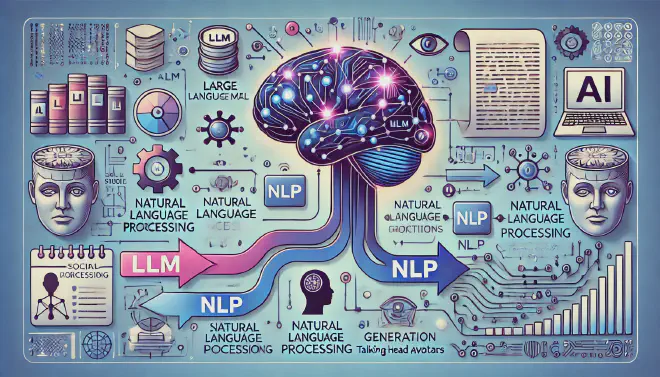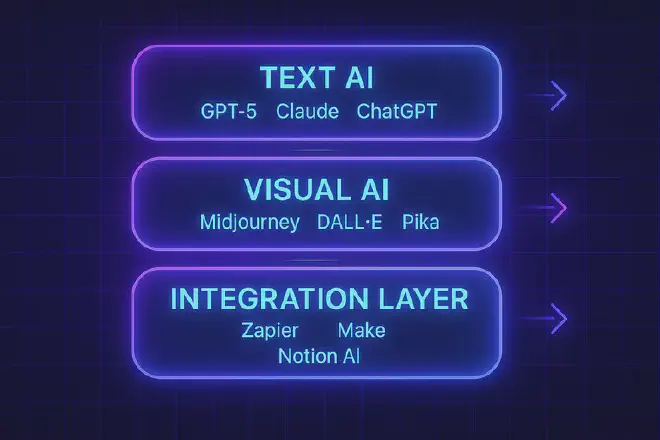The Ultimate Guide to AI Content Creation (Tools, Strategies & Best Practices) #
Hey there! If you’re looking to supercharge your content game—whether you’re a small business owner, freelancer, or content creator—you’ve landed in the right place. Welcome to The Ultimate Guide to AI Content Creation, where we’ll dive into the tools, strategies, and best practices that are transforming how we create everything from blog posts to videos. By the end, you’ll know exactly how to leverage AI to save time, boost creativity, and even make some cash—all while keeping things ethical and SEO-friendly.
Let’s get started!

1. Introduction: What is AI Content Creation? #
Imagine having a tireless assistant who can write blog posts, design social media ads, or even whip up a product video—all in minutes. That’s the magic of AI content creation. It’s the process of using artificial intelligence tools to generate text, images, videos, and more, often with just a few clicks or a well-crafted prompt.
AI isn’t new to content marketing. It’s been quietly powering things like chatbots and recommendation engines for years. But thanks to recent breakthroughs—like OpenAI’s ChatGPT and Google’s advancements in natural language processing—AI has become a game-changer for creators and businesses alike. Why? It’s fast, scalable, and affordable, making it perfect for anyone who needs high-quality content without breaking the bank or burning out.
So, whether you’re a solo entrepreneur needing product descriptions or a marketer juggling multiple campaigns, AI is here to help. Let’s explore how it works and why it’s worth your attention.
2. How AI Content Creation Works #
You don’t need to be a tech wizard to understand AI content creation. At its core, it’s powered by a few key technologies:

Large Language Models (LLMs) #
Think of LLMs like super-smart word generators. Tools like GPT-4 (from OpenAI) or Claude (from Anthropic) are trained on massive amounts of text data, allowing them to write human-like articles, emails, or ad copy. Feed them a prompt—like “Write a blog post about sustainable fashion”—and they’ll churn out a draft faster than you can brew your morning coffee.
Natural Language Processing (NLP) #
NLP is the brain behind AI’s ability to understand and structure content. It helps tools analyze your input, detect tone, and even optimize for readability. Ever wonder how Grammarly catches your typos or how AI rewrites clunky sentences? That’s NLP at work.
Generative AI for Images and Video #
Beyond text, AI can create visuals too. Tools like DALL·E or Midjourney use diffusion models—fancy tech that turns text prompts into stunning images. Meanwhile, video platforms like Synthesia AI transform scripts into talking-head videos with virtual avatars. It’s like having a full creative studio in your pocket!
Together, these technologies make AI a powerhouse for content creation. But which tools should you use? Let’s break it down.
3. Best AI Tools for Content Creation (With Use Cases) #
The AI content toolbox is packed with options. Here’s a rundown of the best tools for different needs, complete with real-world use cases.
Blog & Article Writing #
- Jasper: Perfect for long-form content like blogs. Use it to draft a 1,000-word post on “AI trends in 2025” in under 10 minutes.
- Copy.ai: Great for brainstorming headlines or generating SEO-friendly intros. Try it for a quick “Top 10 Tips” listicle.
- Rytr: Budget-friendly and versatile. Ideal for freelancers writing client articles on tight deadlines.
Social Media & Ads #
- Canva Magic Write: Paired with Canva’s design tools, this crafts snappy captions or ad copy—like “Boost your sales with 50% off today!”
- Predis.ai: Automates social media posts with visuals. Schedule a week’s worth of Instagram content in one go.
- AdCreative.ai: Generates ad variations for Facebook or Google Ads, helping ecommerce brands test what converts best.
Product Descriptions & Ecommerce #
- Writesonic: Writes compelling product blurbs fast. Example: Turn “red sneakers” into “Step bold with these vibrant red sneakers—perfect for any adventure!”
- Shopify Magic: Built into Shopify, it auto-fills product descriptions based on keywords—great for scaling online stores.
Video & Multimedia Content #
- Lumen5: Turns blog posts into slideshow videos with AI-selected visuals. Ideal for repurposing content.
- Synthesia AI: Creates professional talking-head videos without a camera. Use it for explainer videos or tutorials.
- Runway ML: Edits videos or generates animations from text prompts—think “futuristic city flythrough” in seconds.
SEO Optimization #
- SurferSEO: Analyzes top-ranking pages and optimizes your AI content for search engines.
- Clearscope: Suggests keywords and structure to rank higher for terms like “best AI tools.”
- NeuronWriter: Combines content planning with SEO insights—perfect for niche bloggers.
Pick a tool based on your goal, and you’ll be creating like a pro in no time. But is it all sunshine and rainbows? Not quite—let’s weigh the pros and cons.
4. AI Content Creation: Pros & Cons #
AI is a content creator’s dream, but it’s not perfect. Here’s the good, the bad, and the “needs human touch”:
Pros #
- Faster Production & Cost Reduction: Write a blog in 15 minutes instead of 2 hours—or skip hiring a pricey copywriter.
- Personalization at Scale: Tailor emails or ads to thousands of customers effortlessly.
- AI-Assisted SEO Improvements: Tools like SurferSEO ensure your content ranks without guesswork.
Cons #
- Requires Human Oversight: AI can miss nuance or churn out generic fluff. Always edit for quality.
- Ethical Concerns: Plagiarism risks or misinformation can creep in if you’re not careful.
- Google’s Guidelines: Over-reliance on AI without adding value might hurt your SEO (more on that later).
The takeaway? AI is a fantastic co-pilot, but you’re still the captain. Speaking of SEO, let’s tackle a big question…
5. AI Content & SEO: Will Google Penalize AI Content? #
“Will Google ban my site for using AI?” It’s a common worry, but here’s the truth: Google doesn’t care how you create content—it cares about quality. In 2023, Google clarified its stance: AI-generated content isn’t inherently bad, but it must be helpful, original, and user-focused. Spam or keyword-stuffed gibberish? That’s what gets you penalized, AI or not.

How to Make AI Content SEO-Friendly #
- Add Unique Value: Share personal insights or data AI can’t replicate.
- Optimize Naturally: Use tools like Clearscope to hit keywords without overstuffing.
- Fact-Check Everything: AI can hallucinate—verify stats and claims.
- Edit for Humans: Make it engaging, not robotic.
Case in point: A 2024 study by Ahrefs found that 62% of marketers use AI for content drafts, and those who refine it well see no ranking drops. So, polish that AI output, and you’ll be golden.
6. Step-by-Step: How to Use AI for Content Creation #
Ready to jump in? Here’s a simple 5-step process to create killer content with AI:
AI-Generated Content
📝 Blogs
📸 Social Media
🎥 Videos
📧 Emails"]) B(["🚀
Distribution Channels
🌐 Website
📲 Social Media
📩 Email List
📺 YouTube"]) C1(["💰
Affiliate Links"]) C2(["📦
Digital Products
eBooks, Courses"]) C3(["📈
Ad Revenue
Google Ads, Mediavine"]) C4(["🤝
Client Services
Freelance, Consulting"]) C5(["📧
Email Funnels
Leads → Sales"]) D(["🔥
Passive & Scalable Income"]) %% Flow A --> B B --> C1 & C2 & C3 & C4 & C5 C1 & C2 & C3 & C4 & C5 --> D %% Styles classDef start fill:#e0f7fa,stroke:#00acc1,stroke-width:2px,color:#006064; classDef mid fill:#ede7f6,stroke:#7e57c2,stroke-width:2px,color:#4a148c; classDef monet fill:#fff8e1,stroke:#fbc02d,stroke-width:2px,color:#e65100; classDef goal fill:#e8f5e9,stroke:#43a047,stroke-width:2px,color:#1b5e20,font-weight:bold; classDef caption fill:#eef,stroke:#ccc,font-style:italic,font-size:12px; class A start class B mid class C1,C2,C3,C4,C5 monet class D goal %% Caption Caption["From prompt to profit — how AI content feeds your income engine."]:::caption
Step 1: Define Your Content Goal #
What’s the endgame? A blog post to drive traffic? An email to boost sales? Nail this down first.
Step 2: Choose the Right AI Tool #
Match the tool to the task—Jasper for blogs, Canva Magic Write for social posts, etc.
Step 3: Input a Structured Prompt #
Be specific! Instead of “Write a blog,” try: “Write a 500-word blog post about eco-friendly travel tips for beginners, in a friendly tone.”
Step 4: Edit, Refine, and Optimize for SEO #
Cut fluff, add your voice, and sprinkle in keywords. Use SurferSEO to fine-tune.
Step 5: Publish and Track Performance #
Post it, then use Google Analytics or social insights to see what works. Rinse and repeat!
It’s that easy. But before you scale up, let’s talk ethics.
7. Ethical Considerations & Copyright Issues #
AI is powerful, but it raises tricky questions:
Can AI Content Be Copyrighted? #
In the US, the Copyright Office says no—only human-created works qualify. The EU and other regions are similar, though laws are evolving. If you use AI, you might not own the output outright—check your tool’s terms of service.
AI Plagiarism & Originality #
AI pulls from its training data, so there’s a slim chance it could mimic existing content. Tools like Copyscape can help you double-check uniqueness.
Ethical AI Writing Practices #
- Disclose AI use if it’s significant (e.g., “Generated with Jasper, edited by me”).
- Avoid passing off AI work as 100% human if you’re selling it.
- Prioritize accuracy over speed—don’t spread misinformation.
Stay ethical, and you’ll build trust with your audience. Now, how can you turn AI content into cash?
Ethical AI Content Creation: Dos & Don’ts #
| ✅ DOs | ❌ DON’Ts |
|---|---|
| Disclose when significant parts of content are AI-generated. | ❌ Don’t present raw AI output as fully human-created without edits. |
| Fact-check all statistics, claims, and sensitive information. | ❌ Don’t trust AI blindly — it can hallucinate or fabricate data. |
| Edit & Add unique insight to ensure originality. | ❌ Don’t copy-paste AI output without enhancing its value. |
| Respect copyright laws — check tool TOS on ownership. | ❌ Don’t assume you legally “own” AI-generated work everywhere. |
| Use plagiarism checkers like Copyscape or Grammarly. | ❌ Don’t risk duplicate content penalties on SEO or legal fronts. |
| Prioritize helpful content over quantity or speed. | ❌ Don’t publish content just to fill space or trick search engines. |
📝 Pro Tip: Think of AI as your co-writer — not your ghostwriter.
8. Monetization: How to Make Money with AI Content #
AI isn’t just a time-saver—it’s a money-maker. Here’s how:
Selling AI-Generated Content #
Freelancers can use Writesonic to draft articles, edit them, and sell to clients for $50–$200 a pop. Agencies can scale this further.
AI-Assisted Affiliate Marketing #
Write product reviews with Jasper, embed affiliate links (like Amazon or Jasper’s own program), and earn commissions.
Building AI-Driven Niche Websites #
Create a site on “best hiking gear” using AI content + SurferSEO. Monetize with ads or affiliates as traffic grows.
Lead Generation & Email Automation #
Use Copy.ai to craft email sequences, then sell leads to businesses. A single campaign could net $500+.
The possibilities are endless—AI lowers the barrier to entry, so get creative!
9. Future of AI Content Creation #
Where’s this all headed? The future looks wild:

- AI-Powered Storytelling: Imagine interactive novels where AI adapts the plot based on your choices.
- Next-Gen Models: GPT-5 (rumored for 2025) and Claude upgrades will write even more naturally.
- Multimodal AI: Tools blending text, images, and video—like Runway ML on steroids—will dominate.
Plus, AI-human collaboration is trending. Think of AI as your brainstorming buddy, not a replacement. The best content will come from this combo.
🚀 Get Started Today! #
Ready to revolutionize your content? Here’s what to do next:
AI content creation isn’t just a trend—it’s the future. Start experimenting, and watch your productivity (and profits) soar!
